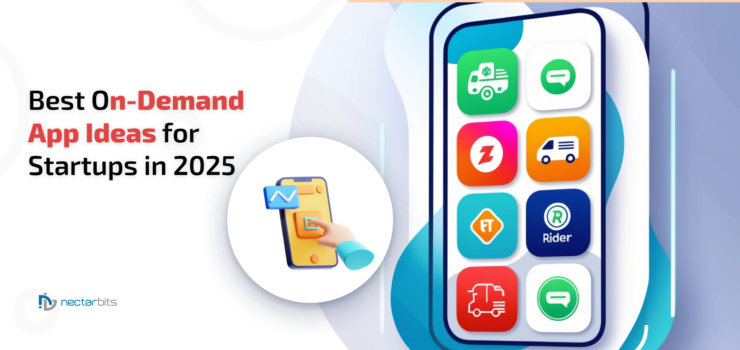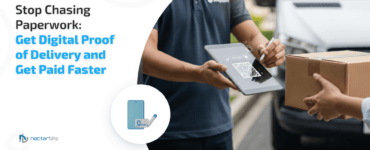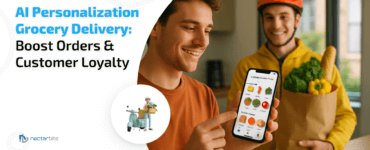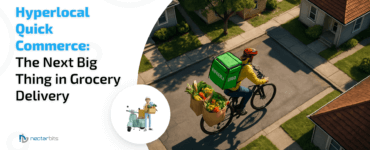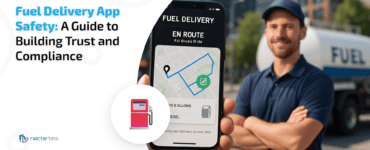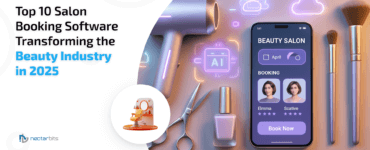As mobile apps continue to sleep deeper into our daily lives, the continual evolution of on-demand apps regularly increases our daily lives’ efficiency by providing a quick fix to our growing desires. There is hardly any global market domain that hasn’t been affected by the growing popularity of on-demand app ideas, as they provide quicker accessibility, a hefty availability of products/services, and greater reliability, all from the comfort of the user’s home.
Projected to cross USD 14.7 Billion by 2030, the on-demand service market is ripe for opportunity and is steadily growing to keep up with the demand of its users who are always ready for the next iteration of an innovative on-demand app idea. Never has the digital society been this convenient to access and make use of as the advent of on-demand app solutions offers a fantastic way to curb and cure your every basic need.
What exactly is an on-demand app, and why are they becoming so popular?
On-demand apps are developed to offer a one-stop solution to consumers by digitizing menial tasks like grocery shopping, housekeeping, food delivery, or bookings. This reduces the need for direct in-person communication between the customers and sellers and allows automation, Machine Learning, and Artificial Intelligence to develop a complex algorithm that improves the more you use the application. This allows the on-demand software solution to predict your desires and offer a more personalized experience.
This is why startup companies have been regularly using on-demand app solutions to launch popular businesses like Uber, TaskRabbit, Zomato, and Urban Company, as a way to capture niches in the market and also profit by inserting themselves as a middleman between the customer and the seller. It’s a win-win-win scenario as sellers see increased sales and revenue from the exposure provided by the on-demand app development, the customer gets added convenience, and the company developing the app solution profits through fees and added charges.
Rise in the On-Demand App Development Economy
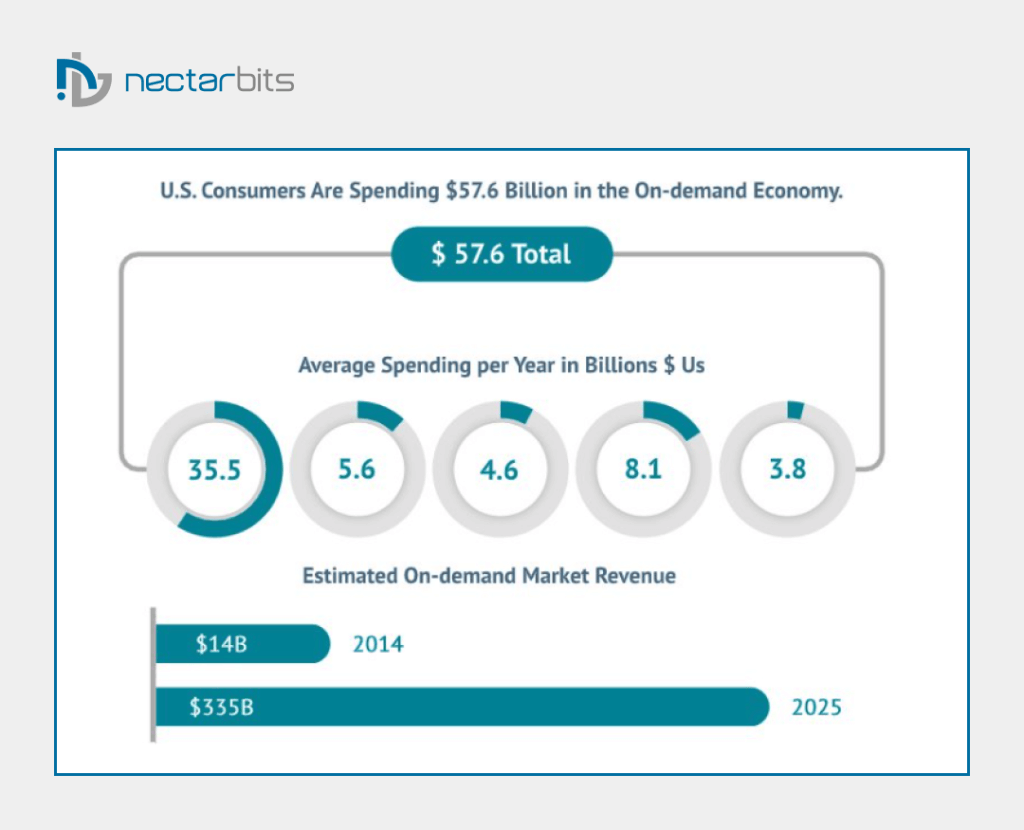
The slew of benefits of on-demand applications translates to the impact of on-demand software development to offer beyond mere convenience. It translates into a booming industry that is projected to reach a staggering $335 billion in revenue by 2025 according to Statista, offers a compelling mix of benefits for both users and businesses.
Benefits of On-Demand App Solutions: Instant Gratification, Powerful Impact
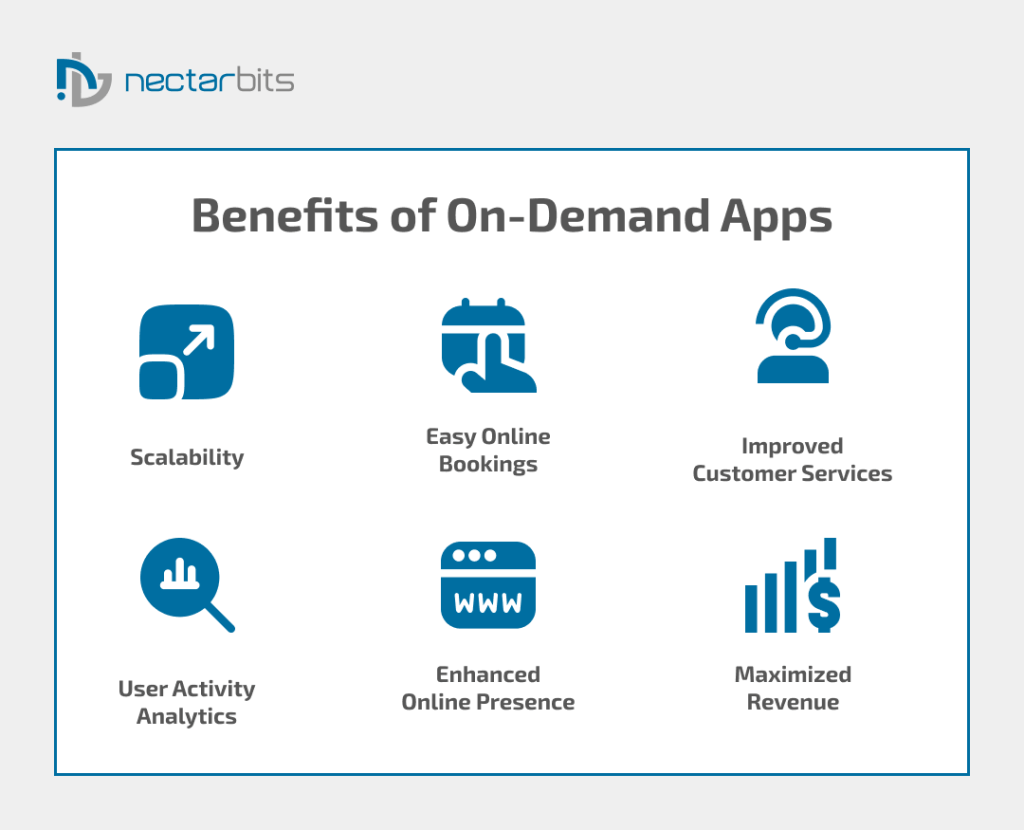
In simple terms, on-demand apps are digital tools aiming to be a one-stop solution for consumers. They render common tasks – such as grocery shopping or bookings – digitally, reducing the need for face-to-face communication. This allows for the application of automation and advanced technologies to develop complex algorithms that learn and improve with use.
Many startup companies use on-demand app solutions to launch successful businesses such as Uber and TaskRabbit. These apps profit by bridging the gap between consumers and sellers and, in turn, profit from associated fees. The sellers see a boost in sales, and the consumers enjoy added convenience.
On-demand apps benefit both businesses and customers. Businesses enjoy increased efficiency and cost savings through automation. They present future growth potential and amplified data security. The insight from analysing app usage provides the ability to personalise offerings, refine marketing campaigns, and enhance customer contentment. Also, businesses get valuable input through user reviews without confrontation.
Benefits of On-Demand Software For Businesses:
Increased Efficiency & Reduced Costs:
On-demand apps are capable of automating tasks like order taking, payment processing, and inventory management. This further streamlines operations, saves valuable time and money, and allows employees to focus on other crucial aspects of the business.
Scalability & Growth Potential:
A typical strategy utilised by businesses is gradually adding features by first developing an on-demand solution that is basic and limited. This technique allows businesses to scale their operations efficiently. Plus, integrating with third-party vendors through an online marketplace model can unlock new revenue streams.
Enhanced Data Security:
On-demand apps can securely store and manage sensitive customer data in private clouds through encrypted methods, limiting access and ensuring compliance with data privacy regulations.
Deeper Customer Insights:
By analysing app usage data, businesses can gain valuable insights into consumer behaviour, preferences, and pain points. This acquired data can be leveraged to personalise offerings, optimise marketing campaigns, and deliver a targeted experience to the user through the on-demand app solution.
Improved Customer Feedback Mechanism:
Anonymous feedback options within the app encourage honest reviews, providing valuable insights into areas for improvement without creating direct confrontation.
Benefits of on-demand software For Customers:
Unmatched Convenience and Accessibility:
On-demand apps readily offer 24/7 access to services, thus reducing the overall limitations of traditional business hours and their restrictions on geographical locations.
Seamless Ordering & Real-time Tracking:
Such apps enhance your ordering experience by making available the real-time location of your goods and the rider, and ensuring that you are always connected with the physical product you ordered.
Flexibility & Control:
On-demand app development allows salient features like easy order cancellation and customizable push notifications that put the user in control of their experience.
Secure & Diverse Payment Options:
Integrated and secure payment gateways facilitate seamless transactions, often with added benefits like interest-free installments that cater to diverse budgets.
Overall, on-demand apps represent a paradigm shift in how businesses operate and how consumers access services. The blend of convenience, efficiency, and data-driven insights creates a powerful synergy that benefits both sides of the equation. As technology evolves, we can expect even more innovative features and applications to emerge, solidifying the on-demand model as a cornerstone of the modern economy.
Top 10 On-Demand App Development Ideas for 2025: Riding the Digital Wave
The on-demand economy is a runaway train showing no signs of slowing down. The on-demand economy isn’t just trending, it’s booming. Consumers crave convenience, and businesses are answering the call with innovative app solutions. Consumers crave convenience, and savvy entrepreneurs are meeting the demand with innovative app solutions. The on-demand economy is a runaway train showing no signs of slowing down. Ready to jump on board?
The on-demand economy is a wild train showing no signs of slowing down. Consumers want it hassle-free, and entrepreneurs with innovative app solutions are helping them achieve it. Ready to jump on board? Here are 10 randomized, future-proof on-demand app ideas packed with fresh insights:
1. On-Demand Microlearning: Knowledge in Your Pocket
Imagine learning something new in engaging bits of information, at any time and place. This is the power of on-demand microlearning. Learning apps nowadays allow learning to fit anywhere, with instant access to fun lessons and tracking of progress, and expanding one’s skill set at your own pace. The future of knowledge sharing is extremely focused on topics explained more intuitively, ensuring that students have a better experience getting involved with their curriculum.
Market Size:
Projected to reach $7 billion by 2030.
Opportunity:
Help make learning more trendy through interactive games and video-based academic content.
- Today’s learners today don’t have much time and want flexibility.
- Your app can deliver bite-sized video lessons and interactive quizzes, with advanced progress tracking.
- Add gamification with badges, leaderboards, and social learning to enhance engagement.
2. Fuel Delivery: Fueling Convenience, Igniting Growth
On-demand fuel delivery apps bring the gas station to your fingertips. It allows you to request a refill at home, or while stuck in traffic, thus saving the user’s valuable time and increasing productivity. In the future, the app will merge seamlessly with smart cars to predict your fuel needs, therefore automating the refuelling process for a hassle-free experience.
Market Size:
Set to hit $596.37 million by 2027.
Opportunity:
Provide ease of access to one of the primary requirements of any vehicle owner across the globe.
- Eliminate refueling hassles with on-demand delivery.
- Partner with gas stations or build your own fleet.
- Target individual drivers and businesses for scheduled fuel top-ups.
- Add loyalty programs, price comparison tools, and eco-friendly fuel options to stand out.
3. Alcohol Delivery: Easy Solution for Your Responsible Indulgence
On-demand alcohol delivery apps make it possible for you to have a curated selection of drinks delivered right to your home, making any moment special. In the future, these apps will be leveraging AI to personalize recommendations based on your taste preferences, virtual sommelier consultations, and subscription boxes based on your taste buds.
Market Size:
Poised to reach a remarkable $173,819.0 million by 2031, growing at a 15.2% CAGR.
Opportunity:
Capture the emerging market of online delivery of alcoholic beverages:-
- Become the go-to for curated alcohol selections, craft beers, or fine wines. Integrate robust age verification and responsible delivery protocols.
- Partner with local breweries or wineries for exclusive offerings. Provide cocktail recipes and pairing suggestions.
4. Grocery Delivery: Reshaping the Grocery Aisles
On-demand apps have made it possible for products to be browsed in the comfort of your home. This allows deliveries to be scheduled for maximum convenience, and goodbyes are said to be crowded aisles and heavy bags. As these platforms evolve, expect hyper-personalized experiences—AI-driven recommendations for recipe ideas, dietary-specific shopping lists, and even predictive ordering that pre-anticipates your needs.
Market Size:
Expected to expand to 20.5% of the total US grocery market by 2026.
Opportunity:
Move beyond basic grocery delivery with hyper-specific niches
- Ability to partner with local farms and offer organic, ethically sourced produce.
- Deliver premium pet food, treats, and toys, and even schedule vet-approved medication deliveries.
- Curate recipe boxes with pre-portioned ingredients, taking the guesswork out of cooking.
5. Telehealth: Healthcare, Anywhere, Anytime
Telehealth apps connect you with doctors and specialists for virtual consultations, even prescription refills and mental health support—all from your home. These apps will be incorporating wearable health data, enabling real-time health monitoring, and facilitating even more advanced remote diagnostics and treatment very shortly.
Market Trend:
The pandemic has resulted in a 50% increase in telehealth usage by adults aged between 18 to 49.
Opportunity:
Build a HIPAA-compliant platform that goes beyond basic consultations:
- Offering online therapy sessions, mindfulness exercises, and mental health resources.
- Remote monitoring, medication reminders, and support for patients with chronic conditions and diseases.
- Connect users with specialists for quick and convenient second opinions.
6. E-hailing: Navigating the Future of Transportation
There’s undeniable convenience when it comes to hailing rides with a single tap on your smartphone. E-hailing apps get people moving, with super-speed transportation options to work, a night out, or navigating a new city. The future of e-hailing brings with it smarter transportation ecosystems that are integrated with ride-sharing options, self-driven cars, and even personalized routes optimized for efficiency and minimum impact on the environment.
Market Size:
Projected to reach an impressive $212.139 billion by 2028.
Opportunity:
Even with big players like Uber and Lyft, there’s room for disruption:
- Offer a fleet of sustainable electric or hybrid vehicles, appealing to the rising awareness of eco-conscious consumers.
- Create a ride-sharing platform for specific demographics, such as senior citizens or college students, offering a more personalised experience.
- Cater to the high-end luxury market with chauffeured rides in luxury vehicles, providing advanced capabilities and better rides at higher prices.
7. On-Demand Personal Financial Advisor: Finance for Everyone
On-demand financial advisors provide the capability of offering personalized financial advice, automated investing, and budgeting tools in a 24/7 time frame. These applications are slowly integrating AI and machine learning, providing hyper-personalized financial planning, market predictions and better encrypted safeguarding financial wellbeing.
Market Size:
This is an up-and-coming market that is still growing, providing a ripe opportunity to be captured by disruptive on-demand app development.
Opportunity:
In an increasingly complex financial world, make financial guidance accessible and affordable:-
- Provide personalized advice to their users
- Automated portfolio management, budgeting tools, and goal-setting features.
- Using AI-powered insights to analyze spending habits and recommend personalized financial strategies.
8. Food Delivery: Serving Up More Than Just Meals
Food delivery applications have transformed the way we dine, opening us to a world of culinary variety at our fingertips. In the future, food delivery will become even more personalized through AI-driven recommendations, integrations of virtual kitchens, and extraordinary culinary experiences, including the possibility of drone delivery for ultimate speed and convenience.
Market Size:
An estimated $275.22 billion market size by 2028.
Opportunity:
Differentiate with laser-focused approaches:
- Collaborate with chefs to offer virtual cooking classes and interactive dining experiences.
- Cater to specific diets with curated menus and transparent ingredient listings.
- Streamline corporate catering with customizable meal plans and group ordering options, which is a highly lucrative option.
9. On-Demand Home Services: Making Housework History
From cleaning and repairs to landscaping and pest control, on-demand home services apps link you up with skilled professionals who can take on that to-do list. Such platforms make the upkeep of your home easy, saving you time and the hassle of finding and screening trustworthy providers. In the future, look for these apps to start offering bundled services, predictive scheduling of routine maintenance based on your home’s needs, and even AR-powered tools to help you make simple DIY repairs.
Market Size:
Growing at an alarming rate with a forecasted $6,396.81 million by 2029.
Opportunity:
Streamline home services with ideas that make everyday work easier in dual-working households.
- Sustainable Cleaning: Offer eco-friendly cleaning services with safe, non-toxic products.
- Smart Home Setup & Support: Connect users with technicians who can install and troubleshoot smart home devices.
- On-Demand Handyman Help: Provide a platform for booking skilled handymen for small repairs and maintenance tasks.
10. Pharmacy Delivery: Prescriptions Delivered, Stress Relieved
Stop waiting in line at the pharmacy and deal with troublesome refill processes. Pharmacy delivery apps bring the pharmacy to you. Order on demand for delivery of prescriptions, over-the-counter medications, and even healthcare products. These apps will integrate with wearable technology and electronic health records, offering personalized medication reminders, automated refills, and proactive management of medications for better health.
Market Trend:
Online prescription orders skyrocketed during the pandemic and look to be a lasting shift in consumer behaviour.
Opportunity:
Go beyond basic on-demand delivery apps by providing a facility for patients to fill their prescriptions without the hassle of going to a pharmacy:-
- Develop a system for tracking refills, setting reminders, and flagging potential drug interactions.
- Offer secure messaging or video calls for quick questions and advice on medications.
- Integrate with healthcare providers to optimize prescription delivery for individuals with chronic conditions and improve the accessibility of their health records.
On-Demand Mobile App Development Cost Breakdown: Cost and Projected Revenue
With so many app ideas, the cost of a mobile app development process is equally varied. Development of an on-demand mobile application can vary significantly, depending entirely on how many features the company is planning to integrate and the number of users benign targeted judging the variety of its offerings. Its deployment and maintenance also incur significant costs, with separate expenditures being reserved for customer service and maintenance of the product itself.
It can range from a modest $10,000 up to $300,000+. Not that this is an arbitrary number, for sure. It heavily depends on the complexity level of the app, the choice of platform, features, and the expertise of the development team.
For example, a simple application with reduced functionality would lie within $30,000-$40,000, and a feature-rich application with custom integrations could require upwards of $300,000. A smart approach for startups would be to first create a Minimum Viable Product, which is essentially a functional prototype of the app with core features, and would cost approximately $20,000 to $60,000.
This allows for market testing and refinement before the full cycle of development is undertaken. Remember, it is very important to communicate your requirements clearly to your chosen development team, which is crucial for accurate estimation of cost and a successful app launch
Mobile App Development Cost Breakdown
| On-Demand App Complexity | Estimated Cost Range | Description |
| Minimum Viable Product (MVP) | $20,000 – $60,000 | A basic version of the app with core features, used for testing and market validation. |
| Basic App | $30,000 – $40,000 | Simple features, and limited functionality, are often suitable for single-purpose apps. |
| Moderately Complex App | $50,000 – $300,000 | More advanced features, integrations, and potentially multiple user roles. |
| Highly Complex App | $300,000+ | Sophisticated features, custom integrations, high-security requirements, large-scale user base. |
Factors Influencing On-Demand App Development Costs: Decoding the Price Tag
While estimates provide a starting point, understanding the variables that impact app development costs is vital.
App Complexity: From Simple Tools to Sophisticated Systems
App complexity is a major cost driver. A simple app costs less than a complex one requiring advanced features and integrations. Remember, even single-purpose apps can be deceptively complex, like Instagram and Spotify, affecting timelines and costs.
Platform and Devices: Navigating the Mobile Landscape
The target audience and their devices influence development costs. Building for iOS differs from catering to a diverse Android user base. Cross-platform development, using frameworks like React Native or Flutter, offers cost savings. But hosting and additional fees change according to the platform.
Development Team: Expertise Comes at a Price
Freelancers are cost-effective but may lack expertise for complex projects. App development companies, while pricier, provide dedicated teams and expertise. The best option to save money is to consult an experienced company that offers developer services on a project-to-project costing basis, such as On-Demand-app.
Features and Functionality: Striking the Right Balance
Each feature, from basic logins to complex integrations, adds development time and cost. Prioritize essential features and consider phased implementations to manage expenses.
UI/UX Design: More Than a Pretty Face
Intuitive design is crucial for user engagement. Custom designs offer uniqueness but are costly, while templates are cheaper but limit customization.
Security: A Non-Negotiable Expense
Protecting user data is vital. Implementing robust security measures, though costly, builds trust and ensures long-term success.
Testing: Ensuring Quality from Day One
Thorough testing throughout development ensures a seamless user experience and identifies issues early on.
Understanding what factors affect the cost of developing your app and communicating openly with your development team are the keys to making informed decisions, managing your budget, and setting your app up for success.
Exploring the On-Demand App Business Landscape and Revenue
Revenue and business models change rapidly depending on the type of on-demand software solution and development you opt for. Changing preferences and requirements can dynamically change these models, and many on-demand software solutions also target multiple business avenues to ensure maximum revenue and userbase.
On-Demand Mobile App Revenue Fragmented By Market Segments
The graph below shows how on-demand software solutions are projected to grow by 2025 in each specific market segment. Notice how the most popular and consistently growing on-demand solution remains in the e-commerce market globally.
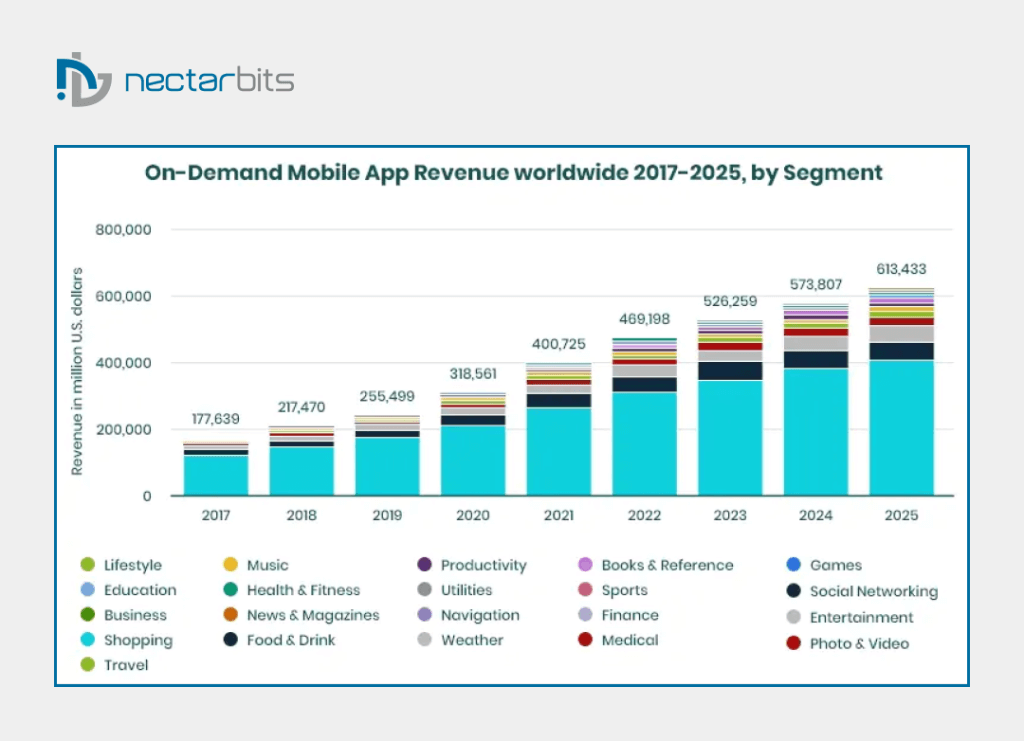
Types of Business Models employed within top On-demand app development solutions
The on-demand economy thrives on diversity, connecting businesses and consumers in innovative ways. Let’s explore the three primary types of on-demand mobile apps fueling this revolution:
1. Powerhouses in Direct-to-Consumer (B2C): Convenience at Your Fingertips
Such platforms ease transactions about almost all types of products and services, from ordering food through apps like Uber Eats and DoorDash to booking travel accommodations with platforms like Airbnb and Booking.com. B2C apps put the power of choice and instant gratification into consumers’ hands.
2. Streamlining Business Operations (B2B): Efficiency Unleashed.
B2B on-demand apps centre around transaction and collaboration optimization between businesses. Imagine a platform that connects manufacturers to raw material suppliers or a service that streamlines the logistics and freight management of e-commerce companies. Examples include platforms like Alibaba for wholesale trade or Upwork for connecting businesses with freelancers.
3. The Sharing Economy Champions (C2C): Power to the People
C2C on-demand software solutions empower one to join in the sharing economy by directly connecting people to trade in goods and services. Great examples are ride-sharing giants like Uber and Lyft, where individuals become service providers, or even platforms like eBay and Poshmark, which turn every user into a seller. C2C apps unlock new sources of income, bring in sustainability through shared resources, and build a community.
Conclusion: On-Demand Apps Make The Future Of Business Fit Inside Your Pocket
The above factors prove that evolution in the on-demand market is not just a trend. This domain’s economy is an integral evolution of business operations and the new manner in which consumers can have access to services. From grocery delivery to business connections spanning continents, on-demand apps transform industries and unlock an unprecedented order of opportunity.
The ease, efficiency, and tailored experiences that these bring have raised the growth to unparalleled levels, making it a lucrative avenue for forward-thinking entrepreneurs.
Ready to unleash the full power of on-demand and define your business in the digital age? Reach out to our team of experts today to help you with your journey!
Frequently Asked Questions (FAQs)
On-demand apps are applications in our devices commonly known as mobile applications that help to make our lives easier by offering us instant access to our day-to-day services. They range from applications such as online food delivery apps to ride-sharing applications, applications that help in finding the nearest plumber or any other service provider, and even telemedicine apps that help connect clients in need of medical advice with relevant professionals. Making mobile apps that allow on-demand access to services means adding convenient user interfaces and ensuring that payment for services is safe and easy.
Mobile applications that specifically demand selling continue to trend as more and more people start embracing the use of applications that have been designed to suit their lifestyles. Hailing these ordering services takes a few taps on the phone while performing it through regular calling or physically getting to the place would have been a bit of a challenge. Hence, other features including real-time tracking of orders and customized notifications make for an empowering and indeed fascinating experience for the users.
The cost to build an on-demand app will depend on the type and complexity of the application it lies somewhere around $20,000 for an MVP app to $300,000 plus for a sophisticated on-demand app with numerous features and API integrations. The aspects that are factored into the final price include The application and its functionality, the target platform – iOS, Android or both, features offered, the experience of the developers and the app support price.
App-based services and businesses can rely on different business models that will allow businesses and customers to get connected properly. The most common three models are: Business to Consumer (B2C), this feature links the business directly to the customer where they can both sell goods and services such as UberEats or Airbnb; Business to Business (B2B) it simplifies the interactions as well as business transactions between businesses like Alibaba or UpWork; and Consumer to Consumer (C2C) which provides the common people with the ability to directly engage in the buying .
On-demand apps are applications in our devices commonly known as mobile applications that help to make our lives easier by offering us instant access to our day-to-day services. They range from applications such as online food delivery apps to ride-sharing applications, applications that help in finding the nearest plumber or any other service provider, and even telemedicine apps that help connect clients in need of medical advice with relevant professionals. Making mobile apps that allow on-demand access to services means adding convenient user interfaces and ensuring that payment for services is safe and easy.
Q. Is on-demand app development a trend that is set to continue?
There is much in on-demand app development in terms of business prospects such as Personalization through AI & Machine learning for an even more customized approach towards user-consumers & Add-on Applications of even newer technologies like Augmented & Virtual reality, Blockchain & IoT for ever more interactive and secure user-consumption experience space. The additional emphasis laid on sustainability, and the expansion of these applications to various new verticals such as healthcare, education, finance and many others will fuel the growth of on-demand apps even further.
It’s critical to understand a number of things in order to establish a successful on-demand app solution. Identifying a target speciality market which has a certain precise requirement, prioritising the user interface design as smoothly with a concentration on the Site’s usability, creating the backend efficiently to handle a high number of accesses, developing correct advertising and marketing strategies to reach out to the target market, and providing standard customer care for good user experience is vital for success. For this, you have two options: to turn to a programmer and develop an application or approach market specialists like us who are familiar with these requirements and have vast experience in designing individual on-demand applications.


